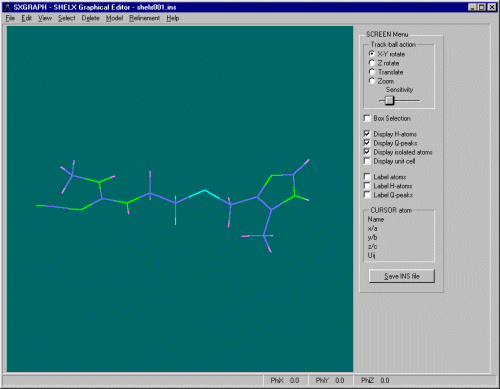SXGRAPH will have no structure in it as there is no solved structure for it to view. Now do File, Open SHELX File and select the Shelx file with the fragment.

This example uses example Cimetidine data from the EXPO software
|
Another option to try and solve the structure is to use a fragment search technique as offered by Dirdif (and Patsee software).
Normally the main problem is to get a fragment is a format that is DIRDIF happy. Using the combination of Ortep-3, WinGX and (the soon to be released) SXGRAPH by Louis Farrugia of Glasgow University, this is quite trivial. It is important that the fragment being used in this case have the Sulphur as part of it or the Patterson fragment search could get quite confused if the heavy atom (being the Sulphur) is not part of the fragment. The ability of Dirdif to solve on the fragment is dependent on how representative on the accuracy of fragment to be in the same conformation as it is in the structure. Obtain a structure file that includes the bit of fragment that you wish to use. This can either be from the Cambridge database, a prior refined structure, or generating the fragment in CORINA from a 2D representation. Ortep-3 can then be used to import a variety of structure file formats and output a Shelx file.
|
|
Run WinGX, go into the directory with the HKL data and fragment (this assumes autostart has
already been run and WinGX has the basic information on the sample) and select Refine, SXGRAPH.
SXGRAPH will have no structure in it as there is no solved structure for it to view. Now do File, Open SHELX File and select the Shelx file with the fragment.
|
|
Then select Delete, All Type, H atoms.
|
|
Use the Box Selection option to click and drag to select the flexible part of
the fragment (not including the sulphur)
Use the Delete, Selected Atoms to delete these atoms.
|
|
Now save the Fragment into a Dirdif happy format using File, Save ATMOD.
DIRDIF ATMOD FileATMOD ATOM C0 0.14787 1.88725 1.17975 ATOM N0 1.68988 -0.10675 0.67875 ATOM C0 0.53988 0.60925 0.48375 ATOM C0 1.63888 -1.17575 -0.14325 ATOM S0 -2.83212 -0.38475 0.03675 ATOM C0 -0.17812 -0.05175 -0.44425 ATOM N0 0.51888 -1.13675 -0.81225 ATOM C0 -1.52513 0.35925 -0.97925 END |
|
Now run Dirdif in fragment searching mode by selecting, Solve, DIRDIF, Orient (or enter the
interactive mode).
|